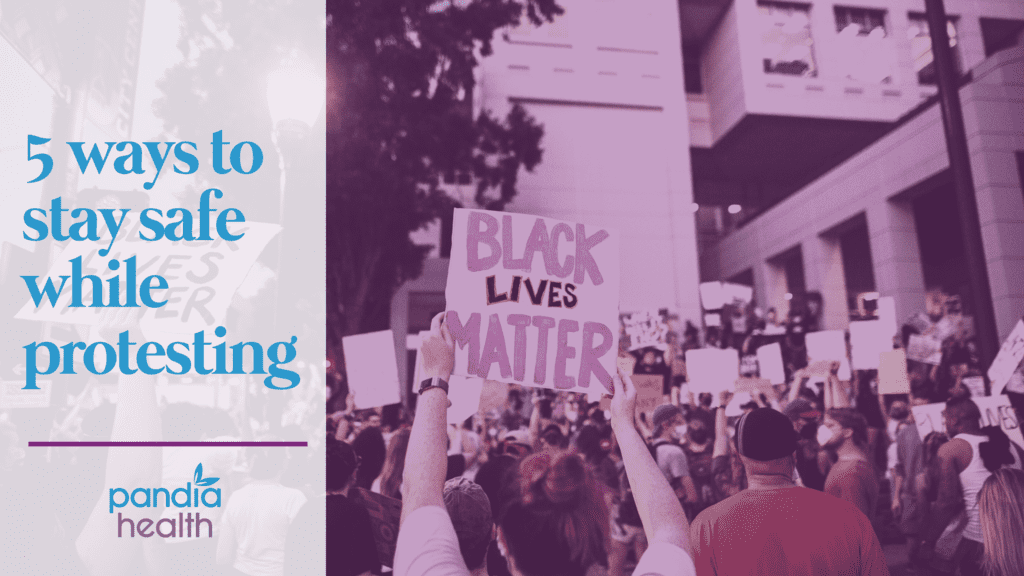Medically reviewed by Sophia Yen, MD, MPH – Written by Pandia Health Editorial Team
Millions of people throughout the United States have shown up to raise their voices and take action in support of the Black Lives Matter movement. Pandia Health stands with the Black community, and individuals who have joined in. Protesting is a great way to start a conversation, create a national debate, and connect with others who are also passionate about issues you care deeply about.
During COVID-19, it is essential to ensure you are doing everything possible to prioritize your health. Additionally, you need to take into account your safety. Protesting may be vital to you, but your physical wellbeing should not be compromised.
Here are 5 ways to stay safe while protesting:
1. Plan Ahead
Make sure you come as prepared as possible. Does the forecast call for rain? Pack a raincoat. Is it going to be 90 degrees? Pack a high non-oil based sunscreen. Planning also means doing your research. Chemicals, like tear gas, can sometimes be used by police during a protest. Oil-based products trap chemicals, so stay away from moisturizers or sunscreen with a lot of oil in them.
If you do run into trouble and need assistance, know where and whom to get it from. Have an emergency plan in place: familiarize yourself with the area, have a designated emergency contact, and mark any known medical stations. Remember, the most control you have is over yourself.
2. Bring the Right Gear
Wearing a mask decreases your risk of exposure to COVID-19 by 65%, so do not forget to wear one when you walk out of the door. A bandana or protective cloth of any kind will work, too. Packing minimally will make your life easier, but part of the bare minimum includes extra safety gear. Your safety gear should consist of a small first aid kit, eye protection, wet wipes, hand sanitizer, and non-oil-based sunscreen.
Also, bring some nourishing snacks (granola bars are a great choice), lots of water, a portable charger, a change of clothing, and cash. Having your identification cards, like a driver’s license and your emergency contact information, is also a good idea if a police officer stops you.
If you are on your period, pack some pads, tampons, or use something like a Diva Cup. If you don’t want your period to get in the way while you’re at a protest (or anywhere for that matter), check out Pandia’s #PeriodsOptional campaign! Your period should be the last thing that blocks you from taking action.
3. Dress Accordingly
Aside from your mask, wear clothing that is comfortable because you may be outside for an extended period of time. If you are standing out in the sun, bring a hat and sunglasses to keep the rays out of your eyes – the last thing you want is a nasty sunburn or sun poisoning.
Plus, you may come into contact with pepper spray or tear gas so wear glasses (or goggles) instead of contact lenses as well as clothing that covers your body – even if it is lightweight, it is better than having your legs, back, and arms exposed. If there is a significant risk of police spraying chemicals into the crowd, wear your goggles throughout the protest.
In the event you are exposed to toxic chemicals, seek medical assistance and change into the extra clothing you packed in order to reduce skin irritation.
4. Know Your Rights
You must know what you can and cannot do before attending a protest. In the U.S., the following rights apply to everyone:
- Freedom of Expression and Assembly
- Protection of the Right to Freedom of Assembly
- Freedom from excessive use of force
- Right to Medical Assistance
- Freedom from Arbitrary Arrest and Detention
- Right to Complain
In other words, within the U.S., you can express your opinion, protest, receive medical care, be told the reasoning for your arrest, and say that you feel your rights have been violated. These rights are most substantial in “traditional public forum” which include sidewalks and streets, as compared to private property, such as a person’s home. In these areas, you are allowed to photograph anything in plain sight, speak out, and march. That said, be conscious that other protestors should not be identifiable within your photos – their safety could be at risk if you post a picture of them.
5. Do Not Go Alone
You should never attend a protest alone so make sure you go with people who you trust. Formulate an emergency plan – decide on meeting spots in the event one of you becomes separated and give each other your emergency contact information in case any of you get injured or arrested.
Pandia Health in Solidarity
We support the Black Lives Matter movement and are inspired by individuals fighting on behalf of the cause. People of color, especially Black folks, have not been given a seat at the table for far too long. Understanding racial injustice in America goes beyond reading headlines. It is essential to continually educate yourself and others, spread awareness, and support businesses owned and founded by people of color, especially female-founders.
Pandia Health is actively working to ensure that more Black voices are heard, and more resources are available. Throughout July and August, we will be publishing more blogs, hosting watch parties on our Facebook, and streaming live Facebook events in support of the Black community. #BlackLivesMatter

